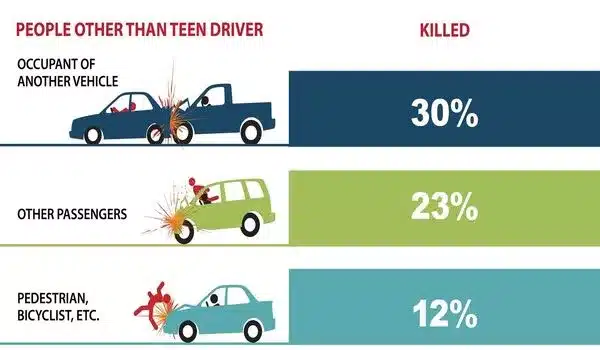Driving skills measured at the time of licensure on a virtual driving assessment (VDA), which exposes drivers to common serious crash scenarios, help predict crash risk in newly licensed young drivers, according to new research. This study moves the research community one step closer to determining which skill deficiencies put young new drivers at a higher risk of crashing. With this cutting-edge data, more personalized interventions to improve driving skills and prevent crashes can be developed.
Driving skills measured at the time of licensure on a virtual driving assessment (VDA), which exposes drivers to common serious crash scenarios, help predict crash risk in newly licensed young drivers, according to new research published today in the journal Pediatrics.
This study, conducted by the Center for Injury Research and Prevention (CIRP) at Children’s Hospital of Philadelphia (CHOP) in collaboration with colleagues from the University of Pennsylvania and the University of Michigan, moves the research community one step closer to determining which skill deficiencies put young new drivers at higher risk for crashes. With this cutting-edge data, more personalized interventions to improve driving skills and prevent crashes can be developed.
Our mission is to enable teens to safely assume the roles and responsibilities that come with transitioning to adulthood, and learning to drive is a major step in that direction. Having an assessment that furthers this goal is an important achievement that we hope will lead to fewer injuries for teens as they first hit the road.
Dan Romer
While drivers aged 15 to 20 account for approximately 5% of all drivers on the road, they are involved in approximately 12% of all vehicle crashes and 8.5% of fatal crashes. The months immediately following the issuance of these young drivers’ licenses are the most dangerous, owing to deficiencies in driving skills.
Many of these newly licensed drivers, however, avoid accidents. Identifying which drivers are at increased risk of crashing during the learning phase before they drive on their own has been a challenge for policymakers, clinicians, and families. When at-risk drivers are identified early, there is an opportunity to intervene with training and other resources known to help prevent crashes, making the roads safer for everyone.
Over the last two decades, CIRP researchers have systematically identified the primary cause of novice driver crashes – insufficient driving skills, such as speed management – and conducted studies that informed the development and validation of a self-guided VDA that measures performance of these driving skills in common serious crash scenarios that cannot be evaluated with on-road testing. The VDA makes use of Diagnostic Driving, Inc.’s Ready-AssessTM platform, which is an AI-driven virtual driving assessment that provides the driver with insights and tools to improve.
In this study, researchers examined the ability of the VDA, delivered at the time of the licensing road test, to predict crash risk in the first year after obtaining licensure in the state of Ohio. Using a unique study design, the results of the VDA were linked to police-reported crash records for the first year after obtaining a license.

“Our previous research showed that performance on the VDA predicted actual on-road driving performance, as measured by failure on the licensing road test. This new study went further to determine whether VDA performance could identify unsafe driving performance predictive of future crash risk,” said lead study author Elizabeth Walshe, PhD, a cognitive neuroscientist and clinical researcher who directs the Neuroscience of Driving team at CIRP. “We found that drivers categorized by their performance as having major issues with dangerous behavior were at higher risk of crashing than average new drivers.”
The researchers examined a one-of-a-kind integrated dataset of individual VDA performance results collected in the Ohio Bureau of Motor Vehicles prior to the licensing road test and linked to licensing and police-reported crash records in 16,914 first-time newly licensed drivers under the age of 25. On the day they passed the on-road licensing examination in Ohio, data were collected from applicants who completed the VDA between July 2017 and December 2019. The researchers examined crash records up to the middle of March 2020.
A Cox proportional hazard model was used to estimate the risk of crash as a function of VDA performance using the outcome of time-to-first crash after licensure. The study discovered that the best performing novice drivers, defined as having “No Issues” based on their VDA driving performance pattern, had a 10% lower crash risk than the average. Users of the VDA who had “Major Issues with Dangerous Behavior” had an 11% higher crash risk than the average. These findings held true after controlling for age, gender, and socioeconomic status.
“These findings are incredibly important because they provide us with quantitative evidence that we can approach young driver safety in a new way — by predicting crash risk and aiming resources to those who need them most,” said Flaura Winston, MD, PhD, co-scientific director of CIRP at CHOP and co-author of the study. “By providing this information before licensure, we can direct resources to those most at risk, and potentially prevent crashes from occurring when these teens first drive on their own.”
“Our mission is to enable teens to safely assume the roles and responsibilities that come with transitioning to adulthood, and learning to drive is a major step in that direction,” said study co-author Dan Romer, PhD, research director of the University of Pennsylvania’s Annenberg Public Policy Center and a partner with Winston and Walshe at CHOP in developing and testing the VDA for teens. “Having an assessment that furthers this goal is an important achievement that we hope will lead to fewer injuries for teens as they first hit the road.”
The VDA is designed to take drivers through a variety of low to high risk, uniquely realistic virtual driving scenarios that can determine where skills are weakest, according to Michael Elliott, PhD, professor of Biostatistics at the University of Michigan School of Public Health and research professor at the Institute for Social Research at U-M and study co-author. Several dozen measures are used to track driving behaviors in real time.
“We know young novice drivers are at higher risk of crashing than more experienced drivers,” Elliott said in a statement. “The novel VDA-tool makes use of data from their actions, such as virtual braking, acceleration, steering, and crashing.” This risk profile has now been shown to predict their crash behavior during their first few years on the road.















